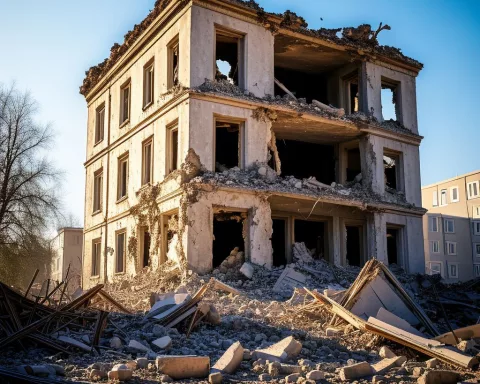In George, South Africa, a massive building collapsed, trapping people underneath. Emergency teams were quickly deployed, and urgent information was disseminated across social media. The incident highlighted the dangers of construction and the importance of safety precautions and prompt emergency responses. Despite the chaos, the George community showed resilience and unity in the face of adversity.
What happened in the George building incident?
In George, South Africa, a five-story building under construction suddenly collapsed, entrapping several people beneath its remnants. The incident prompted a swift emergency response, including the dissemination of urgent information across social networking sites and the deployment of expert emergency teams. The incident highlighted the inherent hazards within the construction sector and underscored the significance of safety precautions and prompt emergency responses.
In the energetic city of George, nestled within South Africa’s Western Cape, a chaotic event burst onto the tranquil scene one regular Monday afternoon. The George building incident, as it would come to be known, commenced when a five-story building under construction on Victoria Street, suddenly fell apart. The erstwhile towering structure was now a pile of debris, entrapping several people beneath its remnants. This abrupt disaster led to a swift emergency response, Victoria Street became a hive of organized pandemonium.
The Immediate Response
As the dust cloud settled over the incident area, the [Garden Route District municipality](https://capetown.today/cape-town-the-enchanting-budget-friendly-destination-for-2023/) wasted no time. They instantly began disseminating urgent information across social networking sites such as Facebook, updating the public about the calamity and the imminent rescue operations. Victoria Road, a pivotal route leading to the disaster zone, was promptly sealed off from York Street. This action was undertaken to provide a clear pathway for the expected stream of ambulances and rescue vehicles rushing to the site.
The directive issued by the municipality to the public was unequivocal: Avoid the disaster site to provide unobstructed passage to emergency services. Yet, a sea of fascinated spectators began to converge at the edges of the catastrophe, their curiosity ignited by the spectacle of the collapse. Reports pointed out that the public’s attempts to get a close-up view of the incident were exacerbating the disorder, adding fuel to an already fraught situation.
The Rescue Operation
In the midst of the riveting rescue operation, unverified reports began to surface suggesting that over 20 construction workers were present inside the building during its downfall. The exact nature and extent of their injuries remained unknown in the immediate aftermath of the collapse. Additional resources were swiftly mobilized to assist in the rescue efforts. Expert emergency teams from Worcester and Cape Town along with a crane from Mossel Bay were quickly deployed to the disaster site.
George’s Mayor, Leon van Wyk, painted a grim picture of the scene. He divulged that the building seemed to have sunk into its own underground parking zone, leaving just a minor mound of debris visible above the surface. The former powerhouse structure was now a mere shadow of its previous self. Images shared on social media starkly juxtaposed the skeletal remnants of the building against its former stage of construction, highlighting the gravity of the incident.
The Aftermath and Reflection
Following the collapse, uncertainty began to swirl around the cause of the incident. Initial probes were inconclusive, but safety became the paramount concern, with the George Municipality promptly sealing off its main building adjacent to the collapsed edifice. This preventive measure remained in effect until additional information was available.
As the dust lifted and the resonances of the collapse dwindled, the tenacity, valor, and collective response of the George community stood in stark relief. The incident served as a testament to the city’s resilience, underlined the inherent hazards within the construction sector, and emphasized the significance of safety precautions and prompt emergency responses. The relentless efforts of the rescue teams, the organized reaction of the municipality, and the public’s cooperation played pivotal roles in overcoming the adversity, demonstrating the power of unity amidst chaos.
What caused the George building incident?
The cause of the George building incident is still unknown as initial probes were inconclusive. Further investigation is necessary to determine the cause of the incident.
How many people were trapped under the building?
Several people were trapped under the remnants of the collapsed building, but the exact number is still unknown. Unverified reports suggested that over 20 construction workers were present inside the building during its downfall.
Were there any fatalities in the George building incident?
It is unclear if there were any fatalities in the George building incident as the extent of injuries sustained by those trapped under the building is still unknown.
What measures were taken to ensure safety after the incident?
After the incident, the George Municipality promptly sealed off its main building adjacent to the collapsed edifice to prevent any further accidents. Further investigation is necessary to determine any additional safety measures that need to be implemented.
How did the George community respond to the incident?
The George community showed resilience and unity in the face of adversity by cooperating with the emergency teams, avoiding the disaster site to provide unobstructed passage to emergency services, and following directives issued by the municipality. The incident served as a testament to the city’s resilience and demonstrated the power of unity amidst chaos.
What lessons can we learn from the George building incident?
The George building incident highlighted the inherent hazards within the construction sector and underscored the significance of safety precautions and prompt emergency responses. It also emphasized the importance of unity and cooperation in overcoming adversity and demonstrated the resilience of the George community.












